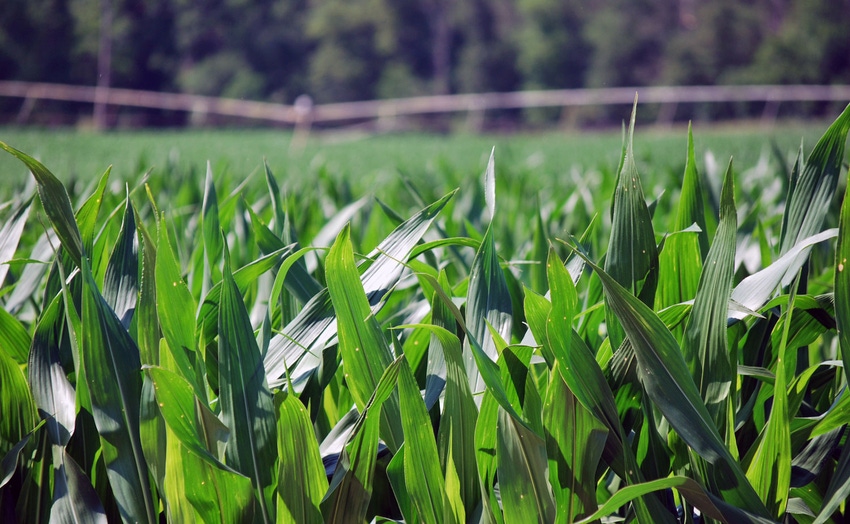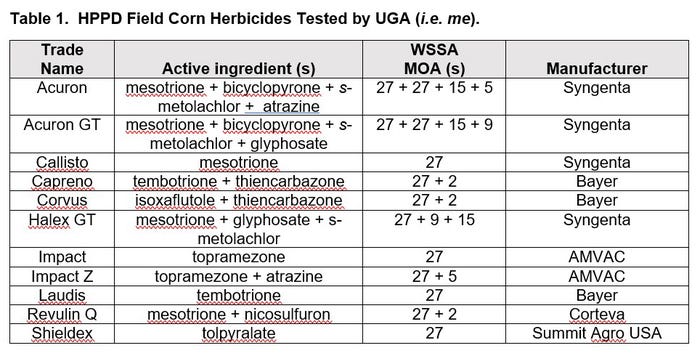January 21, 2021

Over the years, I have noticed many a farmer sleeping during some of my colleagues’ presentations at county production meetings, especially presentations by another UGA weed specialist and a certain plant pathologist.
That said, one of the challenges for an old weed scientist like me is to try to make the discipline of weed science (biology + chemistry + plant physiology + agronomy) interesting, understandable and applicable on the farm. I still might overuse technical jargon that I assume everybody else in the room knows. That is a bad assumption on my part.
You may have heard me or another weed scientist spew out the term HPPD when talking about certain field corn herbicides and their mechanism of action, or MOA. HPPD is an acronym for a plant enzyme known as p-hydroxyphenyl pyruvate dioxygenase. You know why the acronym is used!
Simplified, the inhibition of HPPD by herbicides affects pigment synthesis which results in rapid plant shoot wilting/browning, bleaching/whitening, growth reductions, and plant death. The Weed Science Society of America classifies the HPPD herbicides in Group 27. The WSSA Group 27 number (and any other MOA number) should be clearly listed on the herbicide label.
The HPPD-inhibiting herbicides are not new to the field corn herbicide market. They were first identified in the early 1980s by Zeneca Ag Products, which ultimately became part of the mega-ag-machine now known as Syngenta. Interestingly, the HPPD mode of action was pinpointed by studying the natural herbicidal component (leptospermone) of the bottle-brush plant (Callistemon spp.). Up until last year or so, HPPD-inhibition was the last MOA discovered by the agricultural industry (~40 years ago). For the record, BASF recently discovered a new MOA (WSSA Group 30, fatty acid thioesterase inhibitor).
Over the last 22 years at UGA, I have had the opportunity to test numerous HPPD herbicides for use in field corn. In general, all of these herbicides have performed adequately on many common weeds and especially glyphosate/ALS/atrazine resistant Palmer amaranth. But they also are very likely to cause corn injury in the form of leaf bleaching (Figure 1). Generally, this injury will not result in field corn yield loss as long as the herbicides are applied according to their labels. Of all the products listed in Table 1, I have been less likely to recommend the use of Capreno or Corvus because these tend to more injurious, especially on lighter soils.
HPPD-resistance in Palmer amaranth and tall waterhemp has been reported in several states including Kansas, Illinois, Iowa, Nebraska, North Carolina and Wisconsin. Since the HPPD herbicides have not been abused in Georgia, HPPD-resistance has not yet evolved. Thus, these herbicides should be very beneficial in our on-going battle with herbicide-resistant weeds.
I am hopeful that the next time you hear the acronym HPPD at a weed meeting, it will have more meaning to you. If you have noticed over the past few years that atrazine is not quite working as it used to, you might want to consider including an HPPD herbicide into your field corn weed control program. Before you do, make sure that you understand hybrid tolerance, application rates/timings, rotation restrictions, and their potential use (or not) if in-furrow Counter is needed for soil insects/nematodes.
As always, good weed hunting!

Read more about:
HppdAbout the Author(s)
You May Also Like






